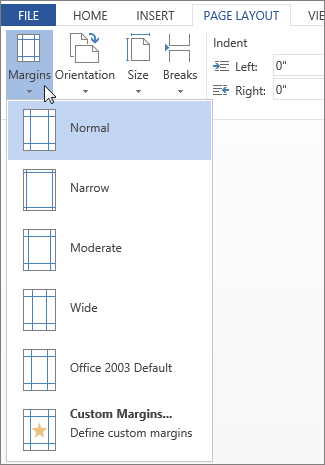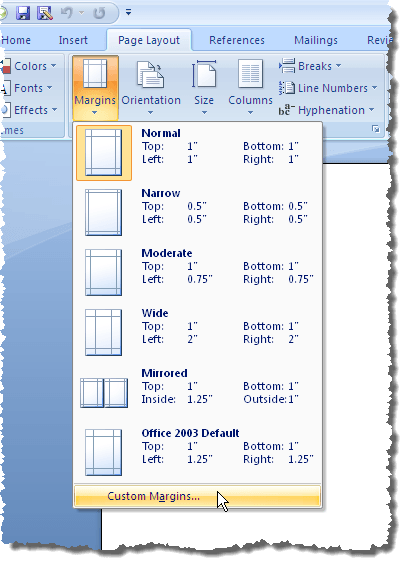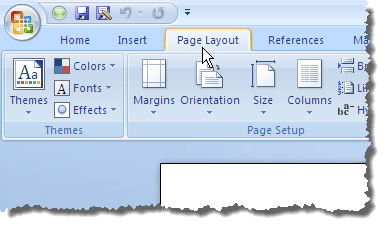- How To Set Margins In Word
- How Do I Set Margins In Word For Macbook Pro
- Set Margins In Word 2010
- How To Set Margins In Word For Mac
- How To Set Margins In Word For Mac
One of the nice things with Mac OS X is that all three browsers that I tested (Safari, Firefox and Opera) have the exact same settings for adjusting the margins of printed pages. Also, once you add this new 'No Margins' setting in one browser on your Mac, it'll be available not only for all the browsers you may have installed, it will also be available for any other applications on your Mac! Very handy huh :)
Step 1: Open Print Page Setup
To begin, click ⌘P, or go to File -> Page Setup (in Firefox) or File -> Print (Safari and most others) to open the Page Setup settings. In the drop down list next to 'Paper Size' choose 'Manage Custom Sizes'. Here's a screenshot to show you the steps:
How To Set Margins In Word

Step 2: Add A Custom Page Size
Jun 28, 2019 Once you’re in Word, head over to the “Layout” tab. In the “Page Setup” group, click the small arrow at the bottom-right. This opens the “Page Setup” window, where you will automatically be on the “Margin” tab. In the “Margins” group, you’re able to set the margins of the page. One way that an Pages inch margin can become larger than a Microsoft inch margin is to have View Show Comments turned on. Another way is if you have a Layout margin on top of a Document margin. So, look in the View menu and in the Layout Inspector, Layout tab. Set document margins for a word-processing document Click in the toolbar, then click the Document tab at the top of the sidebar. In the Document Margins section, click the arrows or enter values in the fields next to Top, Bottom, Left, and Right. Go to View and select Ruler. To show the vertical ruler. Go to File Options Advanced. Select the Show vertical ruler in Print Layout view under Display.
In this window, click the plus sign, rename (double click on it to be able to edit the name) the new custom print setting from the default 'untitled' to something more memorable and descriptive like 'No Margins'.
Step 3: Remove Margins

How Do I Set Margins In Word For Macbook Pro
Then simply type a zero into the top, right, bottom and left spaces like in the screenshot below. If your printer doesn't like taking a zero, try a small margin like .5, each brand is different so your results may vary. That said, mine takes a zero margin but will leave a very tiny bit around the edges anyway.
Set Margins In Word 2010
Step 4: Going to print
When you need to print something without margins (a large image for example), go back to Print... (⌘P) and switch paper size to 'No Margins' (or whatever you'd called your custom page setting). When you'd like to have the defaults back, just change the dropbox to showing US Letter (or the default print setting if it's different in your case).
In Word 2019, you can format entire paragraphs to reduce the monotony of your formatting tasks. Paragraphs are the building blocks of Word documents. Every time you press Enter, you create a new paragraph in a Word document.
You can see the paragraph markers (which don’t print) by clicking the Show/Hide button on the Word 2019 Home tab (in the Paragraph group). This button toggles on/off the display of hidden characters such as spaces, paragraph breaks, line breaks, and tabs. The image below shows a document with the display turned on.
Some folks find seeing these characters very distracting. However, showing them can be very helpful when you’re trying to make sure you have only one space between words, or when you accidentally press the Tab key and make text skip like this — and then fix it.
Each paragraph in Word has a horizontal alignment, which determines how each line aligns between the right and left margins. The default is left alignment, where each line begins at the left margin. Left alignment is appropriate for most situations; the text in most books is left-aligned. The alternatives are
- Right alignment: Each line ends at the right margin. You might use this to right-align the date in some styles of business letters.
- Center alignment: Each line is centered evenly between the margins. You might want to center your name and address on stationery you create.
- Justified: Each line has additional space added to it as needed so that it begins at the left margin and ends at the right margin. With justified alignment, all lines of the paragraph except the last one are spaced that way; the final line of the paragraph is left-aligned. If the paragraph consists of only a single line, it is left-aligned. Newsletter text is often justified, making for a tidier-looking page.
The image below shows some examples of the four types of alignment for a Word document.
How To Set Margins In Word For Mac
To change one paragraph’s alignment, move the insertion point into it, or select any (or all) text within it. Then click the paragraph alignment button you want.
To apply a different alignment to multiple paragraphs at once, select multiple paragraphs (or any part of them). Then click the paragraph alignment button you want.
By default, each paragraph starts in relation to the right and left margins, depending on what alignment you choose for your Word documents. For example, a left-aligned paragraph starts at the same position as the left margin, like this text. Sometimes you might want to indent one or more paragraphs, though: that is, shift their position in relation to the left and/or right margins. For example, in some styles of correspondence, it’s customary to indent the first line of each paragraph by one-half inch (or five spaces). Or, when citing a quotation, it’s common to indent a paragraph by one-half inch at both the right and the left.
Indenting almost always involves shifting the edge of a paragraph inward toward the center of the page, but it is possible to have negative indents, by using negative numbers to specify the indentation amount. Some people call these “outdents,” but that’s just a made-up word.
Here are the possible types of indents in Word.

- First-line indent: Only the first line of the paragraph is indented.
- Hanging indent: Every line of the paragraph except the first one is indented.
- Left indent: All lines of the paragraph are indented in relation to the left margin.
- Right indent: All lines of the paragraph are indented in relation to the right margin.
For a simple left indent, use buttons on the Home tab (Paragraph group): Increase Indent and Decrease Indent. Each time you click one of those buttons, it changes the left indent for the selected paragraph(s) by 0.5.”
If you want to specify the amount of indent or if you want to apply an indent to the right side, use the Indent controls on the Word 2019 Layout tab. (Check here to see more of the Word 2019 ribbon.) You can increment the amount of indent up or down in the Left and Right text boxes.

If you want a special indent (hanging or first-line), use the Paragraph dialog box. To do so, follow these steps:
How To Set Margins In Word For Mac
- Select the paragraph(s) to which the setting should apply.
- On the Home or the Layout tab, click the small icon in the bottom right of the Paragraph group.
- In the Paragraph dialog box that opens, enter values in the Left and/or Right text boxes as desired to create overall indents for the paragraph(s).
- (Optional) If you want a special type of indent (such as hanging, or first-line), open the Special drop-down list and make your selection. Then enter the amount of the special indent in the text box to the right.
In the image above, for example, a hanging indent has been set of 0.9”. That means all lines except the first one will be left-indented by 0.9”.
- Click OK.
The indent settings are applied.